Barolo DOCG Vignarionda
RISERVA
![]()

Grape variety
100% Nebbiolo
Vineyard
Municipality of Serralunga d’Alba, Foglio n. 8, Parcels n. 335, 340 Vineyard surface area: 0,7712 Ha
Exposure: South
Elevation: 360 meters above sea level, on the top of the hill.
Age of vineyards
Varies. The central and largest part, planted before the Oddero family bought the vineyard, probably dates back to 1972. The highest section with about 240 plants was planted in 1983, and the lowest section with about 300 plants in 2007.
Our family began making Barolo Vignarionda in 1985, producing just a few bottles initially and continuing in the successive years with few exceptions. In fact, it was not produced in 1992, 1994, 2002, and in 2003 only 1,200 bottles were made. Since 2010, average annual production is between 2,700 and 3,000 bottles.
Harvest period
Second week of October.
Harvest
The grapes are harvested by hand into 18 kg crates and bunches manually selected. The crates are transported to the winery and the grapes sorted by conveyor-belt prior to entry in the de-stemming machine.
100% Nebbiolo
Vineyard
Municipality of Serralunga d’Alba, Foglio n. 8, Parcels n. 335, 340 Vineyard surface area: 0,7712 Ha
Exposure: South
Elevation: 360 meters above sea level, on the top of the hill.
Age of vineyards
Varies. The central and largest part, planted before the Oddero family bought the vineyard, probably dates back to 1972. The highest section with about 240 plants was planted in 1983, and the lowest section with about 300 plants in 2007.
Our family began making Barolo Vignarionda in 1985, producing just a few bottles initially and continuing in the successive years with few exceptions. In fact, it was not produced in 1992, 1994, 2002, and in 2003 only 1,200 bottles were made. Since 2010, average annual production is between 2,700 and 3,000 bottles.
Harvest period
Second week of October.
Harvest
The grapes are harvested by hand into 18 kg crates and bunches manually selected. The crates are transported to the winery and the grapes sorted by conveyor-belt prior to entry in the de-stemming machine.
Yeld
50 q/ha.
Fermentation and maceration
The grapes are moved to 50 hl fermenting vats, where they undergo alcoholic fermentation with daily racking and returning for approximately 25-28 days.
Time spent aging
Devatting and malolactic fermentation, then decanting and ageing in Austrian oak for a period of about 40 months. After bottling, the bottles are stored in racks in our storage cellar at a controlled temperature of around 15 °C and 70% humidity.
Tasting notes
Intense garnet-ruby red color, deep, limpid. Complex bouquet of dark fruit, blackberries, citrus and rose, balsamic notes of tobacco, liquorice and quina, with nuances of forest underbrush and wet limestone. In the mouth, the wine displays firm tannins, freshness, persistence and longevity.
50 q/ha.
Fermentation and maceration
The grapes are moved to 50 hl fermenting vats, where they undergo alcoholic fermentation with daily racking and returning for approximately 25-28 days.
Time spent aging
Devatting and malolactic fermentation, then decanting and ageing in Austrian oak for a period of about 40 months. After bottling, the bottles are stored in racks in our storage cellar at a controlled temperature of around 15 °C and 70% humidity.
Tasting notes
Intense garnet-ruby red color, deep, limpid. Complex bouquet of dark fruit, blackberries, citrus and rose, balsamic notes of tobacco, liquorice and quina, with nuances of forest underbrush and wet limestone. In the mouth, the wine displays firm tannins, freshness, persistence and longevity.






